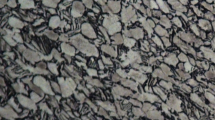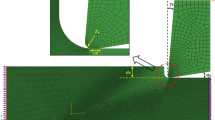Abstract
The finite element modeling is significantly dependent on the accurate prediction of the material behavior. In order to increase the accuracy of numerical simulations, a new phenomenological model is proposed in this study. Its mathematical formulation allows suitable predictions of the Ti6Al4V sensitivity to strain rates and temperatures, while maintaining a low identification cost of its constitutive coefficients. A subroutine VUMAT is developed, and its reliability is investigated in the case of the modeling of uniaxial tensile and impact tests. In addition, the 3D numerical analysis of the machining process is investigated based on the definition of the rheological Johnson-Cook model and the proposed one. Experimental orthogonal machining tests are also established for several cutting conditions. The significant sensitivity of the chip serration, the segments geometry, and the cutting forces to the feed rate is pointed out. Comparisons of the numerical results corresponding to different constitutive models are carried out. High-correlation levels with the experimental results are reached with the definition of the proposed phenomenological model, which is not the case of the Johnson-Cook empirical law. Moreover, intuitive insights about the effect of cutting conditions on the material flow towards the workpiece edges are provided with the 3D modeling. A pronounced increase of the width of side burrs with the feed rate rise was underlined. The results presented in this study point out the inability of 2D numerical simulations to accurately predict the phenomena induced during the machining process, even in the case of an orthogonal machining.
























Similar content being viewed by others
Data availability
The data presented and analyzed in this study are available from the corresponding author on reasonable request.
Code availability
The code used in this study is available from the corresponding author on a reasonable request.
References
Veiga C, Paulo Davim J, Loureiro AJR (2013) Review on machinability of titanium alloys: the process perspective. Rev Adv Mater Sci 34:148–164. https://doi.org/10.3945/jn.109.108399
Arrazola PJ, Garay A, Iriarte LM, Armendia M, Marya S, le Maître F (2009) Machinability of titanium alloys (Ti6Al4V and Ti555.3). J Mater Process Technol 209:2223–2230. https://doi.org/10.1016/j.jmatprotec.2008.06.020
Harzallah M, Pottier T, Senatore J, Mousseigne M, Germain G, Landon Y (2017) Numerical and experimental investigations of Ti-6Al-4V chip generation and thermo-mechanical couplings in orthogonal cutting. Int J Mech Sci 134:189–202. https://doi.org/10.1016/j.ijmecsci.2017.10.017
Pottier T, Germain G, Calamaz M, Morel A, Coupard D (2014) Sub-millimeter measurement of finite strains at cutting tool tip vicinity. Exp Mech 54:1031–1042. https://doi.org/10.1007/s11340-014-9868-0
Chen G, Ge J, Lu L, Liu J, Ren C (2021) Mechanism of ultra-high-speed cutting of Ti-6Al-4V alloy considering time-dependent microstructure and mechanical behaviors. Int J Adv Manuf Technol 113:193–213. https://doi.org/10.1007/s00170-021-06589-3
Ali MH, Ansari MNM, Khidhir BA, Mohamed B, Oshkour AA (2014) Simulation machining of titanium alloy (Ti-6Al-4V) based on the finite element modeling. J Braz Soc Mech Sci Eng 36:315–324. https://doi.org/10.1007/s40430-013-0084-0
Arrazola PJ, Barbero O, Urresti I (2010) Influence of material parameters on serrated chip prediction in finite element modeling of chip formation process. Int J Mater Form 3:519–522. https://doi.org/10.1007/s12289-010-0821-1
Yaich M, Ayed Y, Bouaziz Z, Germain G (2017) Numerical analysis of constitutive coefficients effects on FE simulation of the 2D orthogonal cutting process: application to the Ti6Al4V. Int J Adv Manuf Technol 93:283–303. https://doi.org/10.1007/s00170-016-8934-4
Biermann D, Höhne F, Sieben B, Zabel A (2010) Finite element modeling and three-dimensional simulation of the turning process incorporating the material hardness. Int J Mater Form 3:459–462. https://doi.org/10.1007/s12289-010-0806-0
Franchi R, Del Prete A, Umbrello D (2017) Inverse analysis procedure to determine flow stress and friction data for finite element modeling of machining. Int J Mater Form 10:685–695. https://doi.org/10.1007/s12289-016-1311-x
Haddag B, Atlati S, Nouari M, Znasni M (2010) Finite element formulation effect in three-dimensional modeling of a chip formation during machining. Int J Mater Form 3:527–530. https://doi.org/10.1007/s12289-010-0823-z
Rizzuti S, Umbrello D, Filice L, Settineri L (2010) Finite element analysis of residual stresses in machining. Int J Mater Form 3:431–434. https://doi.org/10.1007/s12289-010-0799-8
Parida AK, Maity K (2017) Effect of nose radius on forces, and process parameters in hot machining of Inconel 718 using finite element analysis. Eng Sci Technol an Int J 20:687–693. https://doi.org/10.1016/j.jestch.2016.10.006
Lurdos O (2008) Lois de comportement et recristallisation dynamique: approches empirique et physique. Thesis, Ecole Nationale Supérieure des Mines de Saint-Etienne
Hor A (2011) Simulation physique des conditions thermomécaniques de forgeage et d'usinage - Caractérisation et modélisation de la rhéologie et de l'endommagement. Thesis, Ecole Nationale Supérieure d"Arts et Métiers _ Centre d'Angers
Ayed Y (2013) Approches expérimentales et numériques de l'usinage assisté jet d'eau haute pression: étude des mécaniques d'usure et contribution à la modélisation multi-physiques de la coupe. Thesis, Ecole Nationale Supérieure d'Arts et Métiers - Centre d'Angers
Hor A, Morel F, Lebrun JL, Germain G (2013) Modelling, identification and application of phenomenological constitutive laws over a large strain rate and temperature range. Mech Mater 64:91–110. https://doi.org/10.1016/j.mechmat.2013.05.002
Johnson GR, Cook WH (1983) A constitutive model and data for metals subjected to large strains, high strain rates, and high temperatures. Proc 7th Int Symp Ballist The Hague, The Netherlands, pp 541–547
Saleem W, Asad M, Zain-ul-abdein M, Ijaz H, Mabrouki T (2016) Numerical investigations of optimum turning parameters—AA2024-T351 aluminum alloy. Mach Sci Technol 20:634–654. https://doi.org/10.1080/10910344.2016.1224019
Molinari A, Cheriguene R, Miguelez H (2012) Contact variables and thermal effects at the tool-chip interface in orthogonal cutting. Int J Solids Struct 49:3774–3796. https://doi.org/10.1016/j.ijsolstr.2012.08.013
Zhang YC, Mabrouki T, Nelias D, Gong YD (2011) Chip formation in orthogonal cutting considering interface limiting shear stress and damage evolution based on fracture energy approach. Finite Elem Anal Des 47:850–863. https://doi.org/10.1016/j.finel.2011.02.016
Yaich M, Ayed Y, Bouaziz Z, Germain G (2020) A 2D finite element analysis of the effect of numerical parameters on the reliability of Ti6Al4V machining modeling. Mach Sci Technol 24:509–543. https://doi.org/10.1080/10910344.2019.1698606
Gavrus A (2012) Constitutive equation for description of metallic materials behavior during static and dynamic loadings taking into account important gradients of plastic deformation. Key Eng Mater 504–506:697–702. https://doi.org/10.4028/www.scientific.net/kem.504-506.697
Ayed Y, Germain G, Ammar A, Furet B (2017) Thermo-mechanical characterization of the Ti17 titanium alloy under extreme loading conditions. Int J Adv Manuf Technol 90:1593–1603. https://doi.org/10.1007/s00170-016-9476-5
Laakso SVA, Niemi E (2016) Modified Johnson-Cook flow stress model with thermal softening damping for finite element modeling of cutting. Proc Inst Mech Eng Part B J Eng Manuf 230:241–253. https://doi.org/10.1177/0954405415619873
Liu S, Kouadri-Henni A, Gavrus A (2018) DP600 dual phase steel thermo-elasto-plastic constitutive model considering strain rate and temperature influence on FEM residual stress analysis of laser welding. J Manuf Process 35:407–419. https://doi.org/10.1016/j.jmapro.2018.07.006
Braham Bouchnak T (2010) Etude du comportement en sollicitations extrêmes et de l’usinabilité d’un nouvel alliage de titane aéronautique: Le Ti555-3. Thesis, Ecole Nationale Supérieure d’Arts et Métiers - Centre d’Angers
Ludwik P (1909) Elemente der technologischen Mechanik. Verlag Von Julius Springer, Berlin
Germain G, Morel A, Braham-Bouchnak T (2013) Identification of material constitutive laws representative of machining conditions for two titanium alloys: Ti6Al4V and Ti555-3. J Eng Mater Technol 135(3):1–11. https://doi.org/10.1115/1.4023674
Xu S, Guo YF, Ngan AHW (2013) A molecular dynamics study on the orientation, size, and dislocation confinement effects on the plastic deformation of Al nanopillars. Int J Plast 43:116–127. https://doi.org/10.1016/j.ijplas.2012.11.002
Balogh L, Brown DW, Mosbrucker P, Long F, Daymond MR (2012) Dislocation structure evolution induced by irradiation and plastic deformation in the Zr-2.5Nb nuclear structural material determined by neutron diffraction line profile analysis. Acta Mater 60:5567–5577. https://doi.org/10.1016/j.actamat.2012.06.062
Yang Y, Liu B (2013) Experimental study on formation characteristics and laws of dislocation and stacking fault during cutting of titanium alloy. Adv Mater Sci Eng 1–7. https://doi.org/10.1155/2013/306728
Brett A Bednarcyk, Jacob Aboudi, Steven M Arnold (2008) The equivalence of the radial return and Mendelson methods for integrating the classical plasticity equations. Comput Mech 41:733–737
Pipard J-M (2012) Modélisation du comportement élasto-viscoplastique des aciers multiphasés pour la simulation de leur mise en forme. Thesis, Ecole Nationale Supérieure d’Arts et Métiers - Centre de Metz
Johnson GR, Cook WH (1985) Fracture characteristics of three metals subjected to various strains, strain rates, temperatures and pressures. Eng Fract Mech 21:31–48
Johnson GR, Holmquist TJ (1989) Test data and computational strength and fracture model constants for 23 materials subjected to large strains, high strain rates, and high temperatures. Los Alamos National Laboratory Report, LA-11463-MS
Ducobu F, Rivière-Lorphèvre E, Filippi E (2016) Material constitutive model and chip separation criterion influence on the modeling of Ti6Al4V machining with experimental validation in strictly orthogonal cutting condition. Int J Mech Sci 107:136–149. https://doi.org/10.1016/j.ijmecsci.2016.01.008
Zhang XP, Shivpuri R, Srivastava AK (2014) Role of phase transformation in chip segmentation during high speed machining of dual phase titanium alloys. J Mater Process Technol 214:3048–3066. https://doi.org/10.1016/j.jmatprotec.2014.07.007
Acknowledgements
The authors gratefully acknowledge the financial support provided for this work by Arts et Métiers _ Campus d’Angers, France, especially the PMD team, and the National School of Engineers of Sfax, Tunisia.
Funding
This study was funded by Arts et Métiers _ Campus d’Angers, France and the National School of Engineers of Sfax, Tunisia.
Author information
Authors and Affiliations
Corresponding author
Ethics declarations
Ethics approval and consent to participate
Not applicable
Consent for publication
All authors consent to the publication of this research work
Conflict of interest
The authors declare no competing interests.
Additional information
Publisher’s note
Springer Nature remains neutral with regard to jurisdictional claims in published maps and institutional affiliations.
Rights and permissions
About this article
Cite this article
Yaich, M., Ayed, Y., Germain, G. et al. Numerical analysis of the Ti6Al4V behavior based on the definition of a new phenomenological model. Int J Adv Manuf Technol 116, 3933–3951 (2021). https://doi.org/10.1007/s00170-021-07753-5
Received:
Accepted:
Published:
Issue Date:
DOI: https://doi.org/10.1007/s00170-021-07753-5




